Summary Overview
Coconut Oil Market Procurement Intelligence: Enhancing Supply Chain Management and Risk Management
Coconut Oil Market Overview
The global coconut oil market is undergoing significant growth, driven by increasing consumer demand for natural and plant-based products. Coconut oil is widely used across food, cosmetics, and industrial sectors due to its versatile applications and health benefits. This expanding market benefits from advancements in processing technology and sustainable practices. Our report provides a comprehensive analysis of procurement trends, emphasizing cost-saving opportunities, risk mitigation strategies, and supply chain optimization through digital tools.
The outlook for the coconut oil market is promising, with several key trends and projections indicating substantial growth through 2032:
-
Market Size: The global coconut oil market is projected to reach approximately USD 11.2 billion by 2032, reflecting a compound annual growth rate (CAGR) of about 5.5% from 2024 to 2032.
Growth Rate: 5.5%. 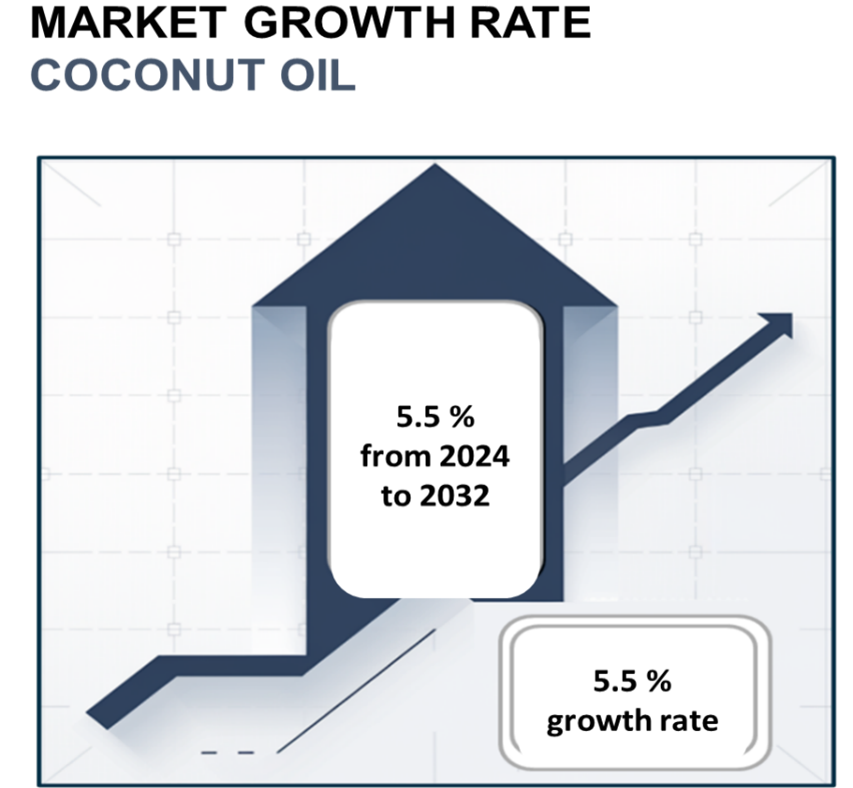
Sector Contributions:
-
Food Industry: Increasing preference for natural cooking oils and health-centric diets drives demand for virgin and refined coconut oil. -
Cosmetics and Personal Care: Coconut oil's hydrating and antibacterial properties make it a preferred ingredient in skincare and haircare products. -
Industrial Uses: The rising adoption of coconut oil in lubricants, biofuels, and chemical manufacturing further supports market expansion.
Technological Transformation and Innovations:
- Precision techniques for oil extraction and refining improve yield quality.
- Adoption of blockchain for enhanced transparency and traceability in procurement.
Funding Initiatives:
- Increased investment in organic farming practices and research to address sustainability challenges.
Regional Insights:
-
Dominance: Asia-Pacific leads the market due to abundant raw material supply and robust production. -
Emerging Regions: North America and Europe are witnessing significant growth owing to rising demand for natural and organic products.
Key Trends and Sustainability Outlook
-
Sustainability Initiatives: Adoption of eco-friendly farming and water-saving irrigation methods. -
Health Trends: Surging interest in organic, non-GMO, and cold-pressed coconut oil. -
E-commerce Growth: Online platforms are broadening the market reach and accessibility of coconut oil products.
Growth Drivers
-
Health Benefits: Coconut oil is valued for its medium-chain triglycerides (MCTs), which support metabolism and energy production. -
Global Population Growth: Increasing population and evolving dietary habits drive demand for edible oils. -
Export Opportunities: Asian producers benefit from rising international demand, particularly from North America and Europe. -
Digital Transformation: The integration of digital tools for inventory and supplier management optimizes procurement processes
Overview of Market Intelligence Services for the Coconut Oil Market
Recent analysis indicates price fluctuations in the coconut oil market due to unpredictable weather patterns and rising production costs. Detailed market reports offer pricing outlooks, cost breakdowns, and procurement strategies that enable stakeholders to address these challenges effectively.
By leveraging insights, buyers and suppliers can minimize risks and achieve cost savings while ensuring the consistent supply of high-quality products. Strategic sourcing, supplier collaboration, and the adoption of digital tools are essential for gaining a competitive edge in this evolving market.
Procurement Intelligence for Coconut Oil Market: Category Management and Strategic Sourcing
To remain competitive in the coconut oil market, companies are focusing on optimizing procurement strategies. Leveraging spend analysis solutions helps in vendor spend analysis, while supply chain efficiency is enhanced through supply market intelligence. Key practices include monitoring proprietary price benchmarks for crude and refined coconut oil in major production regions like Indonesia and the Philippines. Companies are also using global import/export data to manage supply chains effectively and ensure consistent access to high-quality coconut oil for manufacturing and distribution
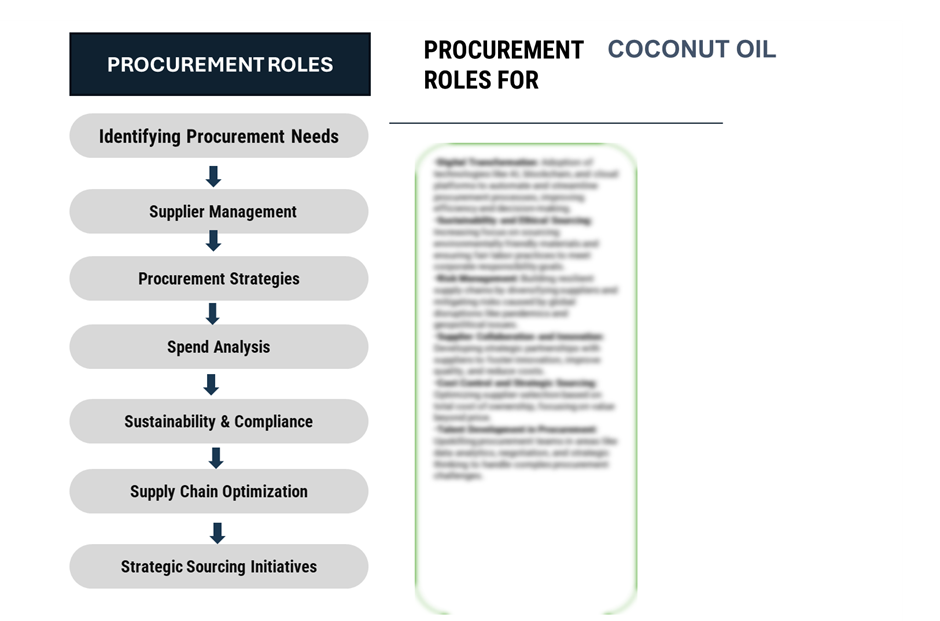 Pricing Outlook for Coconut Oil Market: Spend Analysis
Pricing Outlook for Coconut Oil Market: Spend Analysis
The coconut oil market is experiencing a dynamic pricing landscape influenced by factors such as production costs, global demand, and environmental conditions. The pricing trends from 2024 to 2032 are expected to show gradual increases due to the following factors:
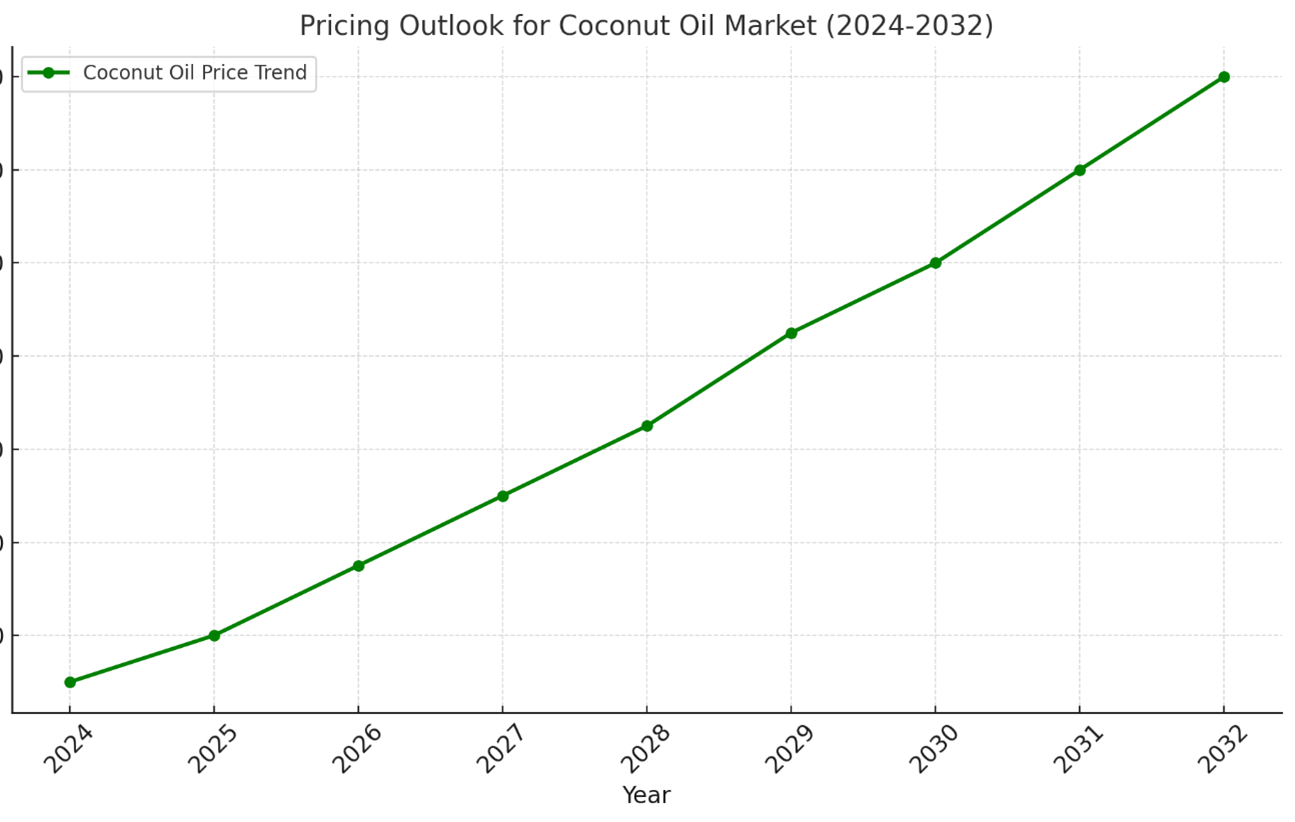
The line chart illustrating the pricing outlook for the coconut oil market from 2024 to 2032.
-
Rising Production Costs: Higher costs for labour, raw materials, and sustainable farming practices are contributing to overall price growth. -
Surging Demand: Increasing applications in health-conscious food products, clean beauty, and wellness sectors are driving demand globally. -
Climate Impact: Environmental factors, including changing weather patterns in key producing regions like the Philippines, India, and Indonesia, are affecting coconut yields and supply consistency. -
Expanding Export Markets: Growing consumer preferences in regions like North America and Europe for natural and organic products are leading to competitive pricing pressures
Cost Breakdown for the Coconut Oil Market: Cost-Saving Opportunities
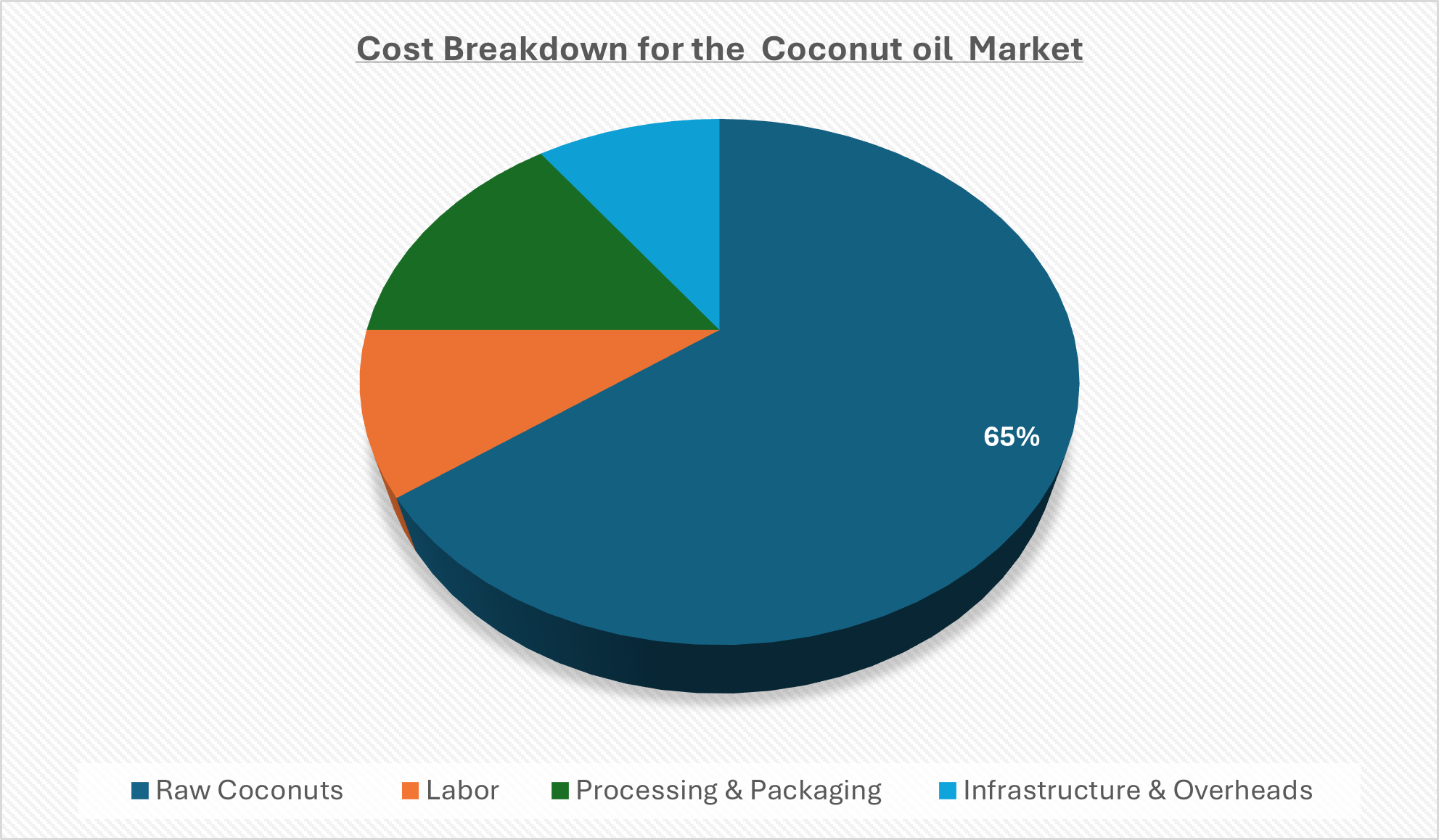
- Raw Coconuts (65%)
-
Description: Represents the primary cost driver, including the price of raw coconuts sourced from major producing regions like the Philippines, Indonesia, and India. The cost is influenced by factors such as harvest yields, transportation, and export tariffs. -
Trends: Prices are experiencing fluctuations due to climatic conditions like typhoons in Southeast Asia and increasing global demand for organic coconut oil. As of 2024, prices are projected to rise moderately, driven by supply constraints and heightened demand in the food and cosmetics industries.
- Labor (XX%)
- Processing & Packaging (XX%)
- Infrastructure & Overheads (XX%)
Cost-Saving Opportunity: Negotiation Lever and Purchasing Negotiation Strategies
In the coconut oil market, cost-saving opportunities include collaborative sourcing for bulk discounts, adopting sustainable farming to reduce input costs, and integrating technology like automated systems to optimize efficiency. Vertical integration lowers processing costs, while energy-efficient facilities and optimized transportation reduce utility and freight expenses. Additionally, marketing cooperatives help share promotional costs, enhancing profitability while managing overall expenditures effectively.

Supply and Demand Overview of the Coconut Oil Market: Demand-Supply Dynamics and Buyer Intelligence for Effective Supplier Relationship Management (SRM)
The coconut oil market is witnessing robust growth due to increasing health awareness, expanding applications across industries, and a rising preference for natural and organic products. Demand is driven by its use in food, personal care, and industrial applications, while supply is shaped by tropical production hubs and evolving farming practices.
Demand Factors:
-
Health and Wellness Trends: Rising focus on natural and organic products drives demand for coconut oil as a healthier alternative in cooking and skincare. -
Diverse Applications: Coconut oil is widely used in food, cosmetics, personal care, and industrial applications like biofuels, supporting sustained demand growth. -
Popularity in Vegan Diets: The shift toward plant-based and vegan diets increases demand for coconut oil as a key ingredient in non-dairy and plant-based foods. -
Global Population Growth: The growing population is boosting demand for edible oils, including coconut oil, as a staple in various regions.
Supply Factors:
-
Tropical Dominance: Major producers like the Philippines, Indonesia, and India dominate global coconut oil production, ensuring a steady supply to meet demand. -
Farming Innovations: Adoption of advanced farming methods, including efficient processing and higher-yield coconut varieties, enhances production capacity. -
Sustainability Initiatives: Increasing use of organic and sustainable farming practices supports supply chain resilience and environmental objectives. -
Export Competitiveness: Strong competition among exporters drives improvements in quality and competitive pricing, ensuring consistent supply.
Regional Demand-Supply Outlook: Coconut Oil Market
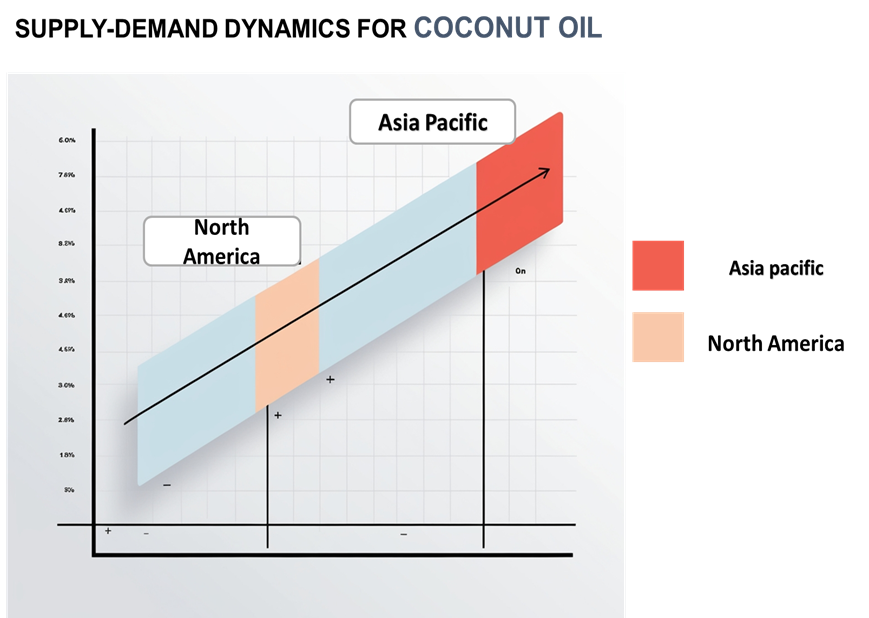 The image highlights growing demand for coconut oil in both Asia-Pacific and North America, with potential price fluctuations and rising competition.
The image highlights growing demand for coconut oil in both Asia-Pacific and North America, with potential price fluctuations and rising competition.
Asia-Pacific: The Dominant Coconut Oil Hub
Asia-Pacific remains the epicentre of coconut oil production and demand, driven by:
-
Top Producers: Countries like the Philippines, Indonesia, and India lead global coconut oil production, supplying major international markets. -
Export Powerhouse: The region exports a substantial share of coconut oil to North America and Europe, strengthening its position in global trade. -
Expanding Applications: Diverse uses in food, cosmetics, and industrial applications fuel regional demand, ensuring consistent market growth. -
Technological Advancements: Investment in efficient processing technologies enhances oil quality and production capacity. -
Sustainability Initiatives: Producers are increasingly adopting sustainable farming and extraction practices to meet growing consumer and regulatory demands.
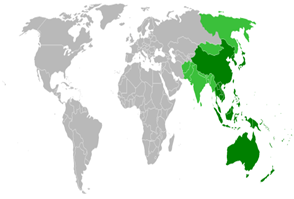
Asia Pacific remains a key hub Coconut oil market and its growth
Supplier Landscape: Supplier Negotiations and Strategies
The coconut oil market features a diverse supplier ecosystem comprising global and regional players that provide essential raw materials, equipment, and services for coconut cultivation, oil extraction, and distribution. Key suppliers offer inputs such as fertilizers, processing machinery, packaging materials, and refining technologies, ensuring the efficiency and sustainability of coconut oil production.
The supplier landscape is marked by close collaborations between producers and suppliers of agricultural and processing inputs. This synergy is vital for improving crop yield, oil quality, and adherence to sustainability standards. Packaging suppliers also play a pivotal role in addressing the rising demand for coconut oil across food, personal care, and industrial applications.
Some of the key raw material and equipment suppliers in the coconut oil market include:
- Wilmar International
- Bunge Limited
- Cargill, Incorporated
- Archer Daniels Midland (ADM)
- Tetra Pak International
- Procter & Gamble Chemicals
- Deutsche Process
- Delft-FEPCO
- BASF SE
- IOI Group
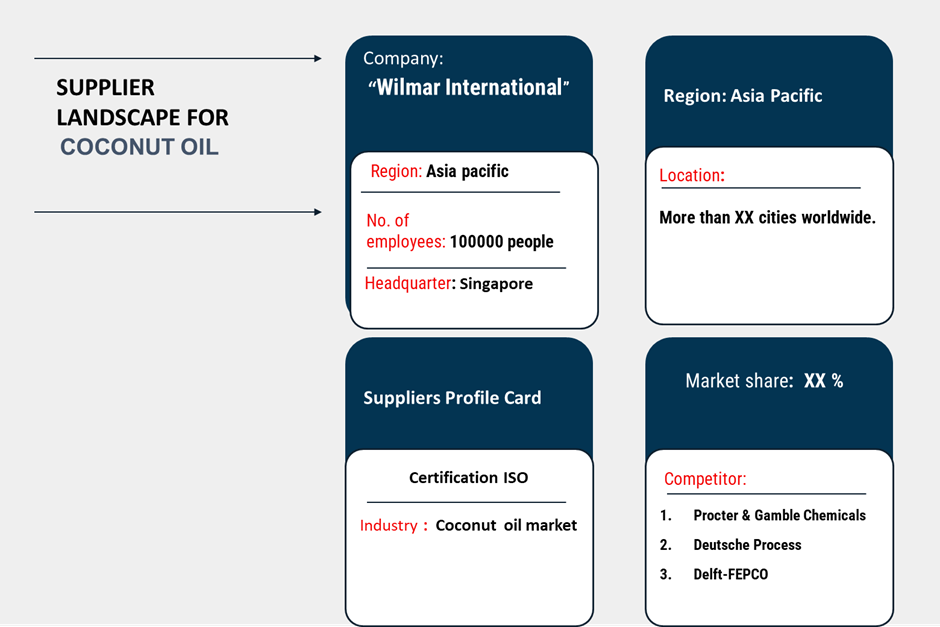
Key Developments: Procurement Category Significant Developments
Category |
Development |
Impact |
Raw Material Sourcing |
Shift towards organic and sustainably sourced coconuts due to increasing consumer demand for clean labels |
Promotes environmental sustainability and attracts health-conscious consumers |
Processing Efficiency |
Adoption of advanced extraction technologies, such as cold pressing |
Enhances oil quality and retains natural nutrients |
Packaging Solutions |
Focus on eco-friendly and biodegradable packaging options |
Reduces environmental footprint and appeals to environmentally conscious buyers |
Supplier Partnerships |
Long-term contracts with coconut farmers and cooperatives |
Ensures consistent supply and price stability |
Technology Integration |
Use of blockchain for traceability in coconut oil supply chains |
Increases transparency and builds consumer trust in product origins and authenticity |
Market Expansion |
Increased investment in emerging markets such as Asia-Pacific and Africa |
Supports market growth and diversification of the consumer base |
Procurement Attribute/Metric |
Details |
Market Sizing |
The coconut oil market is projected to grow from USD 4.23 billion in 2023 to USD 11.2 billion by 2032, with a CAGR of 5.5%. |
Adoption of Coconut Oil-Based Products |
Increased demand for virgin coconut oil, coconut oil-based cosmetics, and health supplements due to its health benefits and versatile applications. |
Top Strategies for 2024 |
Focus on sustainable sourcing, expansion into niche markets (e.g., organic and cold-pressed oils), and improved processing efficiencies. |
Automation in Processing |
Over 35% of facilities are adopting automated cold pressing and centrifuge technologies to improve yield and quality. |
Procurement Challenges |
Key challenges include price volatility due to climatic factors, supply chain disruptions, and rising demand for premium oils. |
Key Suppliers |
Leading suppliers include Marico Limited, Wilmar International, ADM (Archer Daniels Midland), and Bunge Limited. |
Key Regions Covered |
Major markets include Asia-Pacific, North America, and Europe, with significant demand from the Philippines, India, and the U.S. |
Market Drivers and Trends |
Growth is driven by rising awareness of health benefits, increasing use in natural and organic personal care products, and expanding food industry applications. |








